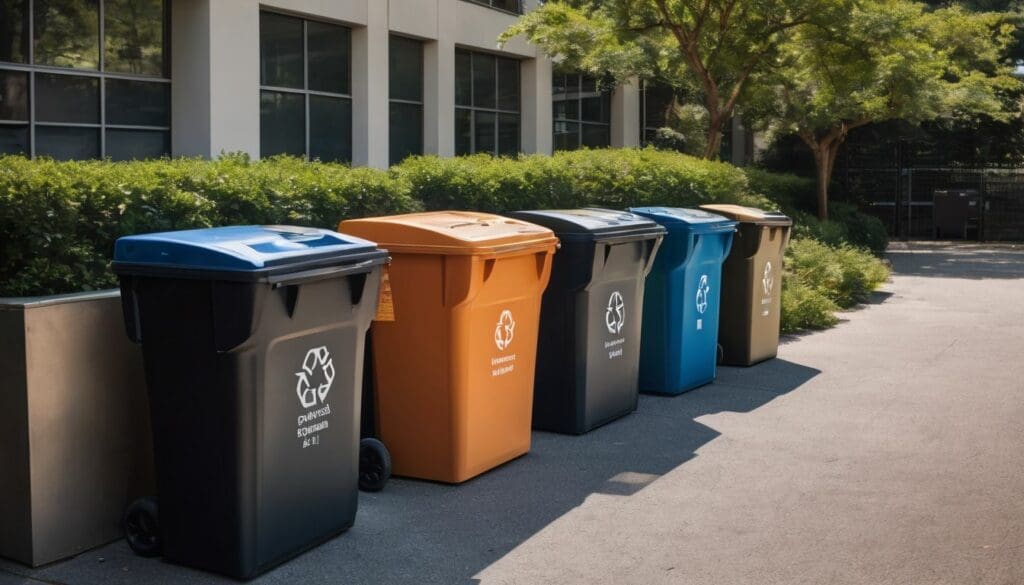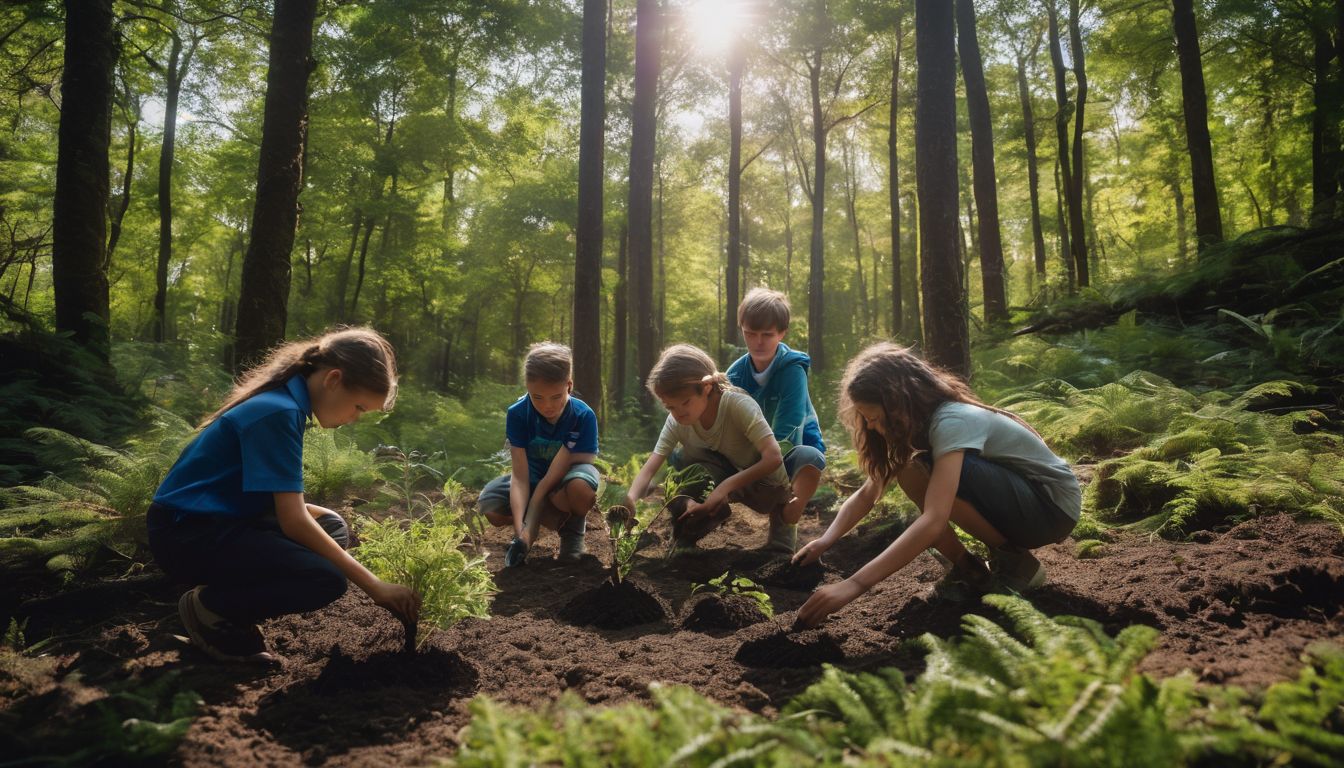Schools everywhere are looking for ways to be kinder to our planet. Did you know, eco-friendly policies in schools can significantly reduce waste and save energy? Our article will guide you through practical steps to make your school greener and more sustainable.
Let’s create a better future together!
Key Takeaways
- Eco – friendly policies in schools, like setting up recycling bins and encouraging walking or cycling, play a significant role in reducing carbon footprints and fostering sustainable habits among students.
- Sustainable school infrastructure, such as energy-efficient buildings and green playgrounds, not only lessens environmental impact but also provides hands-on learning for students about eco-practices.
- Collaborations between schools and local businesses can amplify the effectiveness of sustainability initiatives within the community while enriching educational curricula with practical environmental knowledge.
The Importance of Implementing Eco-Friendly Policies in Schools
Moving from why we need to act towards sustainability, let’s delve into the critical role schools play in this movement. Eco-friendly policies in educational institutions create a living laboratory for students to learn about environmental stewardship.
They witness first-hand how sustainable practices can significantly reduce carbon footprints and conserve natural resources. Schools that embrace eco-conscious programs not only educate but also inspire young minds to become ambassadors of change in their communities.
Embedding green initiatives into school curriculums embeds an ethos of responsibility towards our planet among pupils. It leads the way for environmentally responsible behaviors that extend beyond the classroom walls.
Sustainable school meals, energy-efficient buildings, and waste reduction measures are powerful demonstrations of commitment to the earth’s future. The adoption of such practices fosters a culture where making ecologically sound decisions becomes second nature for tomorrow’s leaders.
Engaging Students and Staff in Sustainability Initiatives
Encouraging walking or cycling to school and implementing car-sharing or public transport programmes for teachers and staff are effective ways to involve students and staff in eco-friendly initiatives.
Incorporating active environmental learning also helps to engage the school community in sustainable practices.
Encouraging walking or cycling to school
- Implementing designated walking and cycling paths around the school grounds can provide a safe and convenient route for students and staff to travel sustainably.
- Organising cycling workshops and training sessions for students and staff can encourage more individuals to choose eco-friendly modes of transportation.
- Introducing a bike – sharing programme at the school can make cycling more accessible for those without their own bicycles.
- Providing incentives such as prizes or recognition for those who regularly walk or cycle to school can help motivate participation in sustainable commuting.
Implementing a car-sharing or public transport programme for teachers and staff
To complement the sustainable transportation practices for students, it’s also pivotal to establish eco-friendly commuting options for teachers and staff. This initiative plays a significant role in reducing carbon emissions and promoting environmental consciousness within the school community. It also sets an example for students, showcasing the importance of alternative transportation methods.
- Introducing a car – sharing scheme that encourages teachers and staff to share rides to and from school. This not only reduces the number of vehicles on the road but also fosters a sense of community among colleagues.
- Collaborating with local public transport authorities to provide discounted or subsidised travel passes for teachers and staff, promoting the use of buses and trains as environmentally friendly commuting options.
- Organising regular workshops or seminars on eco – friendly commuting habits, including information on public transport routes, carpooling guidelines, and the benefits of reducing individual carbon footprints through shared transportation initiatives.
Incorporating active environmental learning
To complement the promotion of sustainable transportation, schools can incorporate active environmental learning initiatives into their curriculum. Engaging students in hands-on activities such as gardening, composting, and wildlife observation can deepen their understanding of environmental issues and encourage a sense of responsibility towards nature.
Additionally, integrating field trips to local conservation areas or inviting guest speakers to discuss sustainability topics can provide real-world context for classroom learning.
Furthermore, involving students in practical projects like tree planting, waste audits, or energy-saving campaigns empowers them to take an active role in reducing their school’s environmental impact.
Promoting Zero Waste and Recycling Practices
Setting up recycling bins in schools can encourage students and staff to recycle, while holding upcycling clubs can help reduce waste and promote sustainability. To learn more about implementing eco-friendly policies in schools, keep reading!
Setting up recycling bins
- Placing clearly labelled recycling bins in high – traffic areas
- Providing educational materials on what items can be recycled
- Organising regular collection schedules for recyclable materials
- Incorporating interactive activities to raise awareness about recycling
- Partnering with local recycling facilities for proper disposal of collected materials
Holding upcycling clubs
- Students can learn about the principles of upcycling and repurposing items, fostering innovation in reusing old materials.
- Upcycling clubs can organise workshops where participants learn how to transform everyday objects into useful items, such as creating storage solutions from old containers or crafting decorations from scrap materials.
- Members can collaborate on upcycling projects for the school, such as creating art installations from discarded materials or repurposing furniture for common areas.
- Club activities can include hosting swap meets or clothing exchanges to encourage sustainable fashion practices and reduce textile waste.
- Members can also organise community outreach programmes to share their knowledge about upcycling with local residents, encouraging wider adoption of eco-friendly practices.
Reducing paper waste
- Setting up recycling bins encourages pupils and staff to dispose of paper waste responsibly, promoting a culture of sustainability within the school.
- Holding upcycling clubs provides an opportunity for pupils to creatively repurpose paper products, reducing the amount of waste generated and promoting sustainable practices.
- Implementing digital platforms for assignments and communications minimises the reliance on paper, contributing to a significant reduction in paper waste production.
- Introducing double – sided printing policies across the school reduces paper consumption and waste, promoting environmentally friendly practices among pupils and staff.
Sustainable School Infrastructure and Operations
Implementing energy-efficient measures and using sustainable materials can significantly reduce the environmental impact of school operations. Green playgrounds, for example, provide a safe and eco-friendly space for students to play and learn about sustainability.
Green playgrounds
Creating green playgrounds in schools is an effective way to promote sustainability and environmental awareness among students. These eco-friendly spaces provide opportunities for outdoor learning while minimising the school’s environmental impact.
By incorporating features such as natural landscaping, recycled materials, and energy-efficient play equipment, schools can inspire a sense of responsibility towards the environment in students.
Introducing sustainable elements into playground design also encourages creativity and physical activity, aligning with the school’s commitment to holistic education. Additionally, involving students in the planning and maintenance of green playgrounds fosters a sense of ownership and pride in their school environment.
Energy efficiency measures
Implementing energy efficiency measures in schools is crucial for reducing environmental impact and cutting down on utility costs. The following initiatives can help make school operations more sustainable:
- Installing LED lighting throughout the school to reduce energy consumption and maintenance costs.
- Upgrading heating, ventilation, and air conditioning systems with energy-efficient models to decrease energy usage.
- Implementing a smart energy management system to monitor and control energy usage in different areas of the school.
- Conducting regular energy audits to identify areas for improvement and track progress in reducing energy consumption.
- Educating students and staff about the importance of conserving energy through awareness campaigns and educational programs.
- Incorporating renewable energy sources such as solar panels or wind turbines to generate clean energy for the school.
Use of sustainable materials and design considerations
Schools can consider using sustainable building materials and designs to reduce their environmental impact. Utilising eco-friendly materials such as reclaimed wood, recycled metal, and low VOC paint can help minimise the school’s carbon footprint.
Incorporating energy-efficient design elements like natural lighting, proper insulation, and solar panels is also crucial in reducing energy consumption. Implementing green infrastructures like green roofs, rain gardens, and permeable pavement not only reduces stormwater runoff but also creates a more sustainable learning environment for students.
Furthermore, integrating sustainable design considerations into school facilities can offer hands-on learning opportunities for students while promoting environmental stewardship. This approach aligns with the growing emphasis on sustainability within educational institutions and equips students with practical knowledge about eco-friendly practices.
Collaboration with the Community and Industry
Schools can partner with local businesses to implement sustainable initiatives and include environmental education in the curriculum. Involving students in sustainability projects for the community fosters a sense of responsibility towards the environment.
Partnering with local businesses for sustainable initiatives
Partnering with local businesses for sustainable initiatives can significantly enhance the eco-friendly efforts of a school. This collaboration serves as a beneficial platform to promote environmental awareness, foster community engagement, and support sustainable practices in schools.
- Establishing Green Partnerships:
- Supporting Local Eco-Friendly Suppliers:
- Promoting Environmental Education:
- Encouraging Student Involvement:
- Showcasing Sustainable Practices:
Including environmental education in the curriculum
- Integrating environmental topics into various subjects such as science, geography, and citizenship studies.
- Organising field trips to nature reserves, recycling facilities, or organic farms to allow students to experience sustainability practices firsthand.
- Encouraging project-based learning that focuses on addressing real-world environmental challenges.
- Collaborating with environmental experts and organisations to provide guest lectures and workshops for students.
Involving students in sustainability projects for the community
- Organising community clean – up drives to promote environmental cleanliness and awareness.
- Collaborating with local conservation organisations for tree planting activities and wildlife preservation projects.
- Designing and implementing sustainable gardening projects within the school premises, fostering an understanding of organic farming and food production.
- Partnering with local authorities for educational campaigns on reducing plastic waste and promoting responsible waste management practices.
- Establishing recycling programmes in the community, such as collecting electronic waste for proper disposal or conducting paper recycling workshops.
Conclusion
In conclusion, eco-friendly policies in schools are crucial for fostering a sustainable environment. Engaging students and staff in sustainability initiatives creates a culture of responsibility towards the planet.
Implementing zero waste and recycling practices instils valuable habits that contribute to a greener future. Sustainable infrastructure and operations pave the way for energy-efficient and environmentally conscious school facilities.
Collaboration with the community and industry strengthens the impact of eco-friendly measures, ensuring lasting environmental benefits for all stakeholders.
FAQs
1. What are eco-friendly policies in schools?
Eco-friendly school policies involve implementing sustainable practices and green initiatives that reduce the environmental impact of educational institutions.
2. Why should schools implement green technology and initiatives?
Schools should use green technology and start eco-conscious programs to teach students about sustainability and help create environmentally friendly school facilities.
3. Can sustainable education practices make a difference in the environment?
Yes, by teaching sustainable practices, schools raise environmental awareness among students who can then contribute positively to creating a more ecoconscious society.
4. How do eco-friendly classroom initiatives benefit students?
Ecofriendly classroom activities encourage students to engage with their environment responsibly, fostering an understanding of how their actions impact the world around them.
5. What types of sustainable school projects can be introduced?
Schools can introduce various projects like recycling drives, planting trees or gardens, using renewable energy sources, and promoting green curriculum subjects.
6. Are there special programs for environmental education in schools?
Many schools have special green programs and initiatives that focus on educating students about the environment through hands-on activities and real-world learning experiences.





